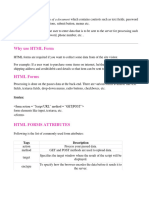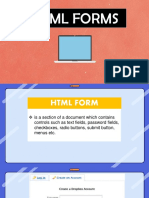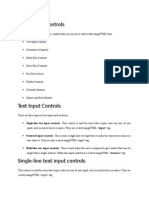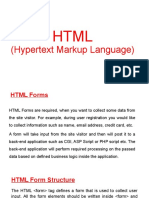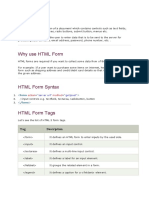0% found this document useful (0 votes)
57 views37 pagesUnit 4 Forms
The document discusses HTML forms and their components. It defines what an HTML form is and its purpose of facilitating user input. It explains the syntax of a basic form and important attributes like action and method. It describes different form controls like text, password, textarea, checkbox, radio, select and their usage. It provides examples and attributes for each form component.
Uploaded by
Portgas D SamCopyright
© © All Rights Reserved
We take content rights seriously. If you suspect this is your content, claim it here.
Available Formats
Download as PDF, TXT or read online on Scribd
0% found this document useful (0 votes)
57 views37 pagesUnit 4 Forms
The document discusses HTML forms and their components. It defines what an HTML form is and its purpose of facilitating user input. It explains the syntax of a basic form and important attributes like action and method. It describes different form controls like text, password, textarea, checkbox, radio, select and their usage. It provides examples and attributes for each form component.
Uploaded by
Portgas D SamCopyright
© © All Rights Reserved
We take content rights seriously. If you suspect this is your content, claim it here.
Available Formats
Download as PDF, TXT or read online on Scribd
/ 37




